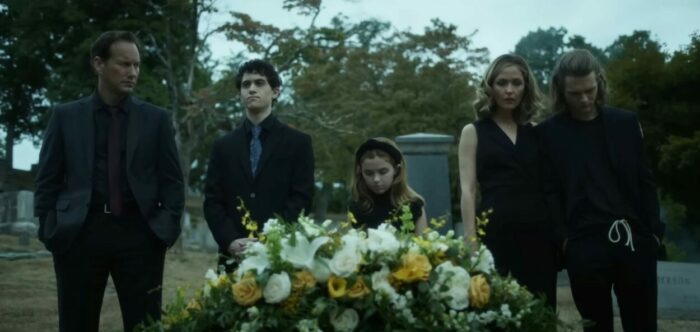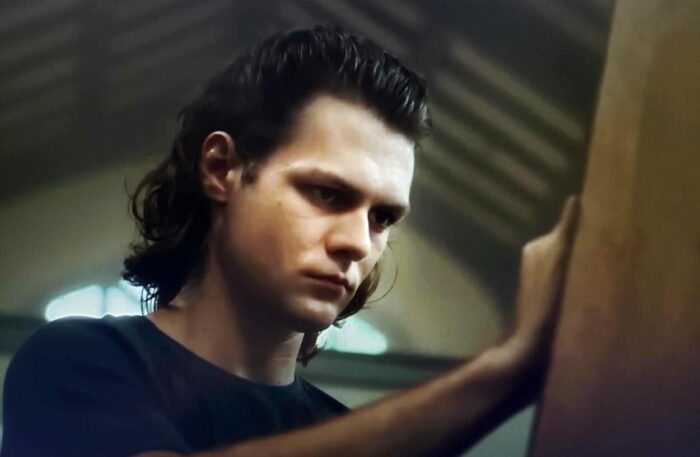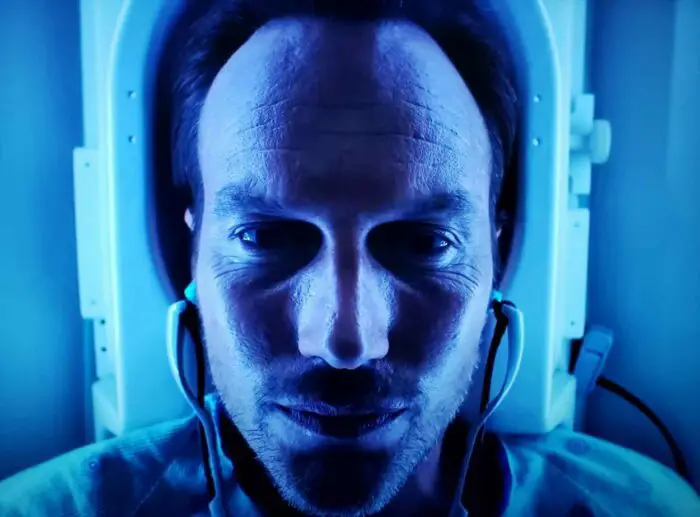The past is a haunting refrain in Insidious: The Red Door. The paranormally plagued Lambert family returns in this latest franchise installment where old wounds are meant to bleed fresh. Some scares will make audiences shiver, but the shadow cast by the first Insidious looms large. At its best, this film sings the same song which isn’t bad but is nothing new.
Insidious: The Red Door opens roughly nine years after Insidious: Chapter 2. The tormented family from that film has fractured, but hoping to bridge the growing gap between them, Josh Lambert is urged by his estranged wife Renai to drive their son Dalton to college. There to study art, diving into his craft inadvertently resurrects buried horrors. As Dalton explores these burgeoning truths, he comes closer to what haunts him in more ways than one. His personal journey into childhood trauma soon follows a trail of terrors that could get him, and others killed or worse.

Where the film shines are its setups. Plenty of great moments build tension. Clever lighting choices, blurred backgrounds, and superb blocking help establish incoming frights. Even predictability is typically turned into nail biting anticipation. Waiting for the ghost to bite, so to speak, is a common aspect of the movie. Yet, there are one or two instances where, well aware of this, Insidious: The Red Door hurls a sledge instead of a predictable hammer. That’s to say, the audience will probably guess something is about to happen, but not the intensity with which it occurs.
Performances are also a solid contribution. Ty Simpkins and Patrick Wilson reprise their roles as Dalton and Josh Lambert. In many instances, the turmoil they experience is written across their faces. There’s almost no need for dialogue. However, thankfully there are some solid lines for Sinclair Daniel as Chris Winslow who is wonderfully effusive. Her lively character is a great counterpoint to Dalton’s brooding. She’s charmingly comedic, but also a kind companion when things become sinister. And while she initially encourages forays into what seems like spooky fun, once the danger is clear she’s a refreshingly definite voice of reason.
The one downside to performances is the lack of Rose Byrne. Her character Renai is too absent from the film, and not showing her side of the story feels like a lost opportunity. The overarching theme is dealing with trauma, yet Renai Lambert is so integral to such a narrative, it’s strange she’s been sidelined. Her entire character’s backstory between films is regrettably an exposition dump. Sadly, that’s a common stumbling block for Insidious: The Red Door.

One advantage to sequels is that stories can typically hit the ground running. Most elements are generally already established, so there’s no need to spend much time on what previous installments explored. Unfortunately, it’s been so long since the previous films Insidious: The Red Door is connected to that rehashing backstory is somewhat necessary. However, writer Scott Teems scripted little to no dialogue which smoothly integrates character histories. Everything past becomes a disgorging of details the movie needs to hurdle as they’re hurled out.
This is particularly true during the movie’s closing act. Details are rushed through in rapid dialogue in order to race towards final scenes that don’t feel entirely earned. It’s like circling back at sixty miles an hour to speed by some scenery in a blur that indicates the emotional destination.
Still, the overall scares are the real meat of the movie. There’s plenty for audiences, horror hounds especially, to sink their teeth into. Not all the vicious ghosts may be as memorable as the Lipstick-face Demon, Bride in Black, or the Man who Can’t Breathe, but they are certainly unsettling in their moments.

Additionally, the opening credits deserve praise. Too often movies nowadays begin with bland title sequences which do nothing to serve the movie. Insidious: The Red Door, however, is a rare treat. Not only does it subtly serve as a refresher on previous films, but it also offers character development. It features a series of drawings, steadily improving in quality. As such, there’s a real impression of young Dalton growing into a talented artist, but also his struggle to understand terrible thoughts and memories peeking through the veil.
Patrick Wilson takes the helm in his feature directorial debut. Strategically, Insidious: The Red Door is the right film for such a first step. Familiarity with the franchise as well as his time in the Conjuring cinematic universe have Wilson working in a presumably comfortable setting. After all, let’s be honest, both films pull from the same tackle box of terrors. Jump scares being the primary tool tormenting audiences. But the larger point being, he manages to recreate the feel of previous films making Insidious: The Red Door seem like an authentic part of the franchise.
Part of that is no doubt thanks to cinematographer Autumn Eakins. Visually the film recaptures lighting established by John R. Leonetti. That mix of a blue grey world juxtaposed against the eerie darkness full of saturated pinpoints of light in The Further. The only downside is there isn’t a lot of cinematic risk.

Consequently, a lot of the movie seems bottled up. The Further, for example, doesn’t feel like a vast ethereal place the way it did in previous films. It just seems like the same rooms with different lighting and fog.
Still, the set ups for scares more often than not establish the right unsettling mood. Although it brings nothing new except lore, it follows the franchise formula well enough to frighten. Solid performances, especially by Sinclair Daniel, maintain the tone certain scenes need. Whether that’s lively and comic to break the tension so the audience can breathe, or bring in a reason to care about what happens. Fans of the franchise will definitely enjoy the film, and those in need of a fresh fright flick should have their horror-tooth sated. Though perhaps not the best the franchise has to offer, Insidious: The Red Door is worth cracking open.


